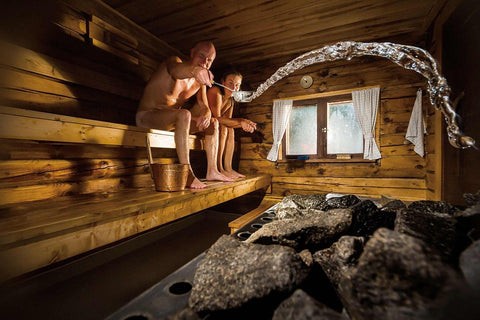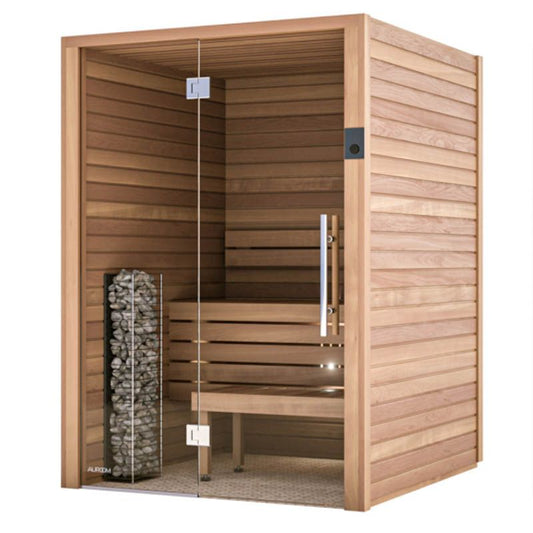Traditional Sauna for Beginners
Traditional Sauna for Beginners
Blog Article
About Traditional Sauna
Table of ContentsThe Buzz on Traditional SaunaThe Ultimate Guide To Traditional SaunaThe Best Strategy To Use For Traditional SaunaWhat Does Traditional Sauna Do?Traditional Sauna - Truths
Power financial savings is one point to take into consideration for people that plan on using their sauna frequently. For a typical sauna, bathers typically need to wait for 30-40 minutes for the room to preheat before entering. Infrared saunas, on the other hand, usually reach their suitable temperature level in about 15 minutes.That indicates that in an infrared sauna, bathers can begin appreciating their sauna promptly. One distinction between both kinds of sauna that is often forgotten is the social experience. Typical saunas are usually big enough to fit several people and allow for mingling. Infrared saunas are generally smaller sized in size, offering even more of an exclusive getaway and less of a social experience.
Also, think about the amount of people will be using the sauna before making your choice. Including a sauna to your home can be one of the most exciting and fulfilling decisions you'll ever before make. Routine sauna usage will certainly improve your blood circulation, preserve much healthier skin, support kidney feature, lower blood stress, improve mind function, and a lot more
The Only Guide to Traditional Sauna

Infrared and standard completely dry saunas are both popular options for those looking for leisure and restorative benefits. However, there are some crucial differences in between both types of saunas that need to be considered prior to making a choice. Standard dry saunas utilize warmed rocks to produce steam, while infrared saunas use infrared heating systems to directly warm the body.
Aspects such as warmth resistance, preferred degree of detoxing, and overall wellness needs to be taken into consideration when choosing which sort of sauna to utilize. Infrared saunas are a sort of sauna that use infrared light to warm the body directly, instead than warming the air around the body like standard saunas.
The temperature level in an infrared sauna is generally less than in a standard sauna, with temperature levels varying from 120F to 150F. Traditional Sauna. Infrared saunas supply a variety of benefits that make them an eye-catching option for those seeking to improve their wellness and wellbeing. Several of the advantages of infrared saunas include: Infrared saunas make use of lower temperature levels than conventional saunas, which can make them more comfy for those that find heats hard to tolerate
See This Report about Traditional Sauna
Infrared saunas have been shown to help the body remove toxic substances with sweating. Sweating can also help to improve skin health by getting rid of contaminations and dead skin cells.
The warmth created by infrared saunas can assist to boost blood flow and boost flow. Infrared saunas have been shown to assist minimize anxiety and advertise relaxation.

9 Easy Facts About Traditional Sauna Explained

There are several benefits to utilizing a traditional dry sauna. Right here are a few: Leisure: The high temperature and reduced moisture in typical completely dry saunas can assist unwind the muscle mass and lower stress degrees. Detoxing: Sweating in a sauna can help eliminate contaminants from the body, which can improve overall wellness.
When it comes to saunas, there are two major kinds of home heating methods: standard and infrared. Traditional saunas utilize warmed air to heat the body, while infrared saunas use infrared Check Out Your URL radiation to permeate the skin and warm the body from within. Among the major distinctions between both approaches is the sort of heat they produce.
Conventional saunas warm the air, which after that heats up the body with convection. Infrared saunas, on the other hand, heat the body directly with radiation.
In terms of power effectiveness, infrared saunas are generally more efficient than conventional saunas due to the fact that they need much less power to operate. They also warm up faster, so they can be used for link much shorter sessions. When it involves the effects on the body, both kinds of saunas have actually been revealed to have benefits.
The 15-Second Trick For Traditional Sauna
Infrared saunas have been revealed to have similar advantages, as well as potentially assisting with cleansing, skin wellness, and immune feature. On the whole, the selection between a conventional or infrared sauna boils down to individual preference and private demands. Standard saunas might be much better for those who favor greater temperature levels and a more extreme sweat action, while infrared saunas may be much better for those that want a more gentle and reliable warm therapy.
Both kinds of saunas supply special advantages and drawbacks that ought to be thought about before deciding. The choice in between an infrared sauna and a traditional completely dry sauna mostly depends on individual preference and the desired benefits - Traditional Sauna. Those that choose an even more comfy, reduced temperature level setting may prefer an infrared sauna, while those that are searching for intense warmth and a standard sauna experience might favor a traditional dry sauna
Here are some security pointers to maintain in mind when making use of infrared and standard dry saunas:: Saunas can cause excessive sweating, resulting in dehydration. It is necessary to consume alcohol lots of water in the past, throughout, and after sauna sessions to remain hydrated.: It is suggested to limit sauna sessions to 20-30 minutes to stay clear of overheating and dehydration.
Report this page